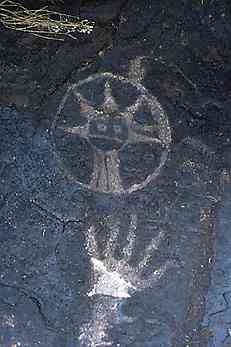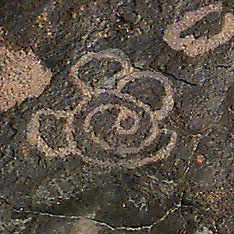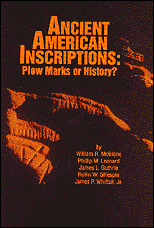|
The Mystery of Ancient America's
ViewZone will attempt to give you all the details.
Tilley admits that the data from his dig will likely only reveal evidence of Native American occupation, as this was their choice of locations and style of dwellings. He speculated that any earlier cultures would probably have left signs in the cave under the boulder, which would have been the initial shelter for this camp. To date, he has found a few pieces of flint and some evidence of a hearth and, of course, the stone walls. But all of this sheds no light on the people who made the Thamudic symbols in the same area -- or does it?
Looking at the rocks we find some petroglyphs right where we were standing. We can see a face with two eyes and a kind of halo made from sun-ray shapes. Not far from it we find another petroglyph, this one looking rather familiar.
We'd think it more likely the case that these shapes are symbols, that is shapes which represent entire concepts such as "a living thing, a thing that curves to the left, on the top of a high place, at the bottom of..." This would not only have been consistent with human development prior to conceiving an alphabet, but it would have been especially important to use symbols in a land where many different sounding languages were encountered.
In our travels to the three mesas that make up the small Hopi Reservation, we were told that each mesa had a different Hopi dialect that was not understood by the others. This was within an area of a hundred miles! It is certainly conceivable that the ancient Native Americans conceived a means to use universally understood symbols -- not a phonetic alphabet -- to mark such important things in stone for viewing by other cultures and times.
But what do YOU think? Maybe something in this story has suggested an area of interest or exploration... We'd really like to hear from you.E-mail to expedition@viewzone.com.
We end with some pictures of other petroglyphs from around the globe. You will see some similarities and you will make your own conclusions. Certainly this area of America needs to be researched by some experts. It holds too rich a yield in the answers to our true origins and of the early inhabitants of North America.
|




 If you are interested in more information and science on the Colorado Rocks, there is an excellent book, unbiased and also speculative, that is available from the author, Bill McGlone. To obtain one of these books, please contact Bill at 1214 San Juan, La Junta, Colorado. The books are $24.95, check or money order. Don't forget to include your mailing address.
If you are interested in more information and science on the Colorado Rocks, there is an excellent book, unbiased and also speculative, that is available from the author, Bill McGlone. To obtain one of these books, please contact Bill at 1214 San Juan, La Junta, Colorado. The books are $24.95, check or money order. Don't forget to include your mailing address.